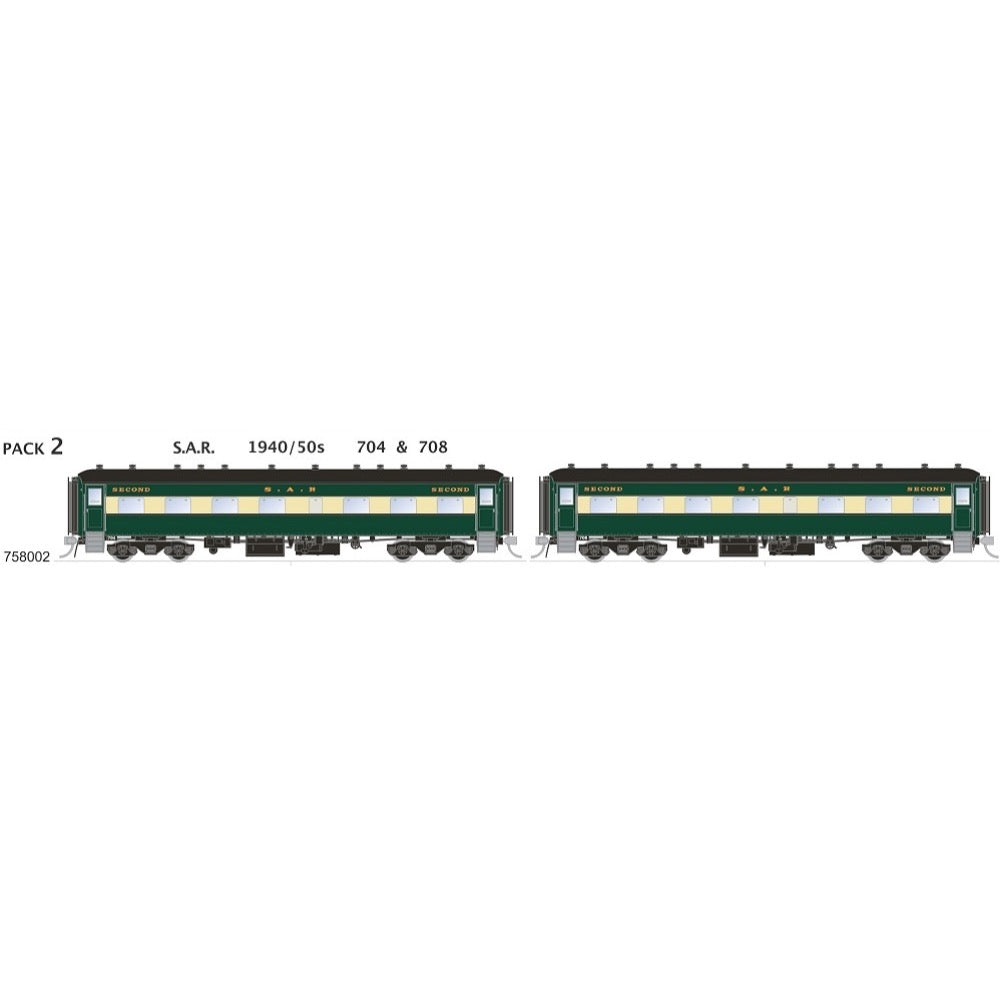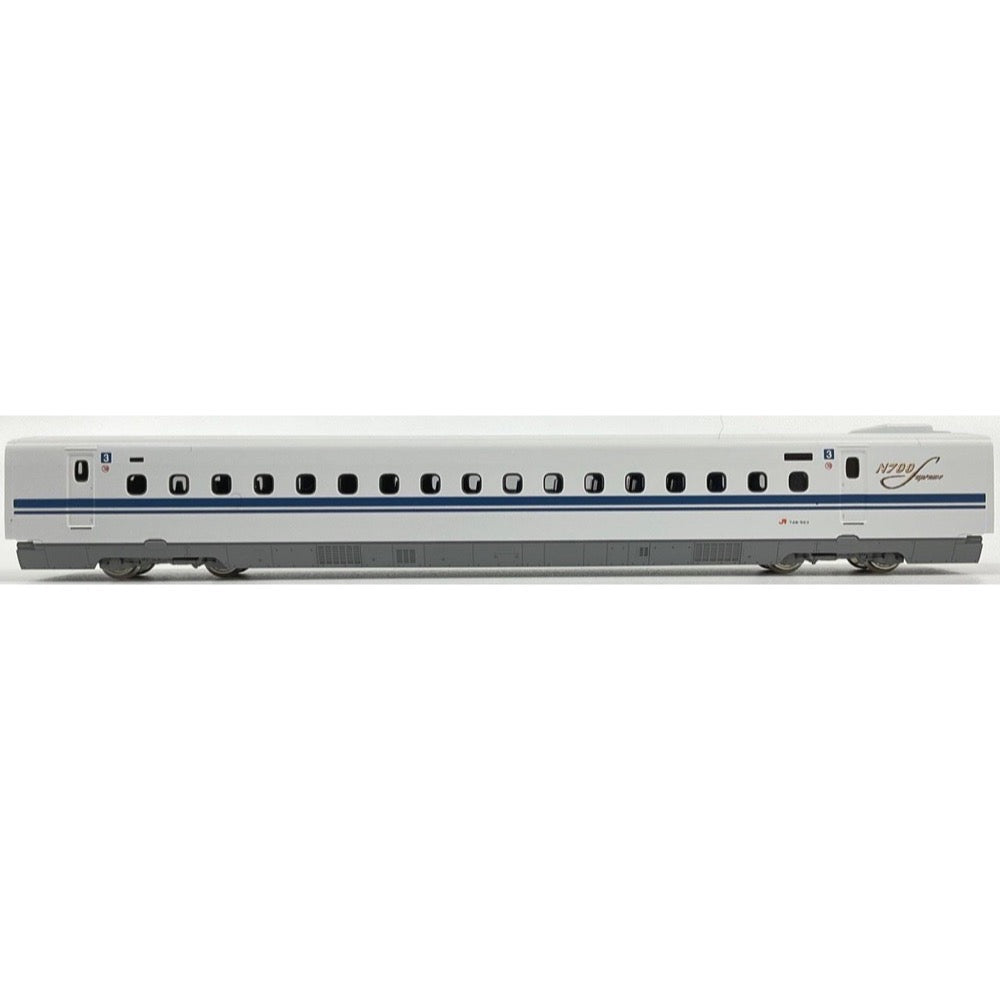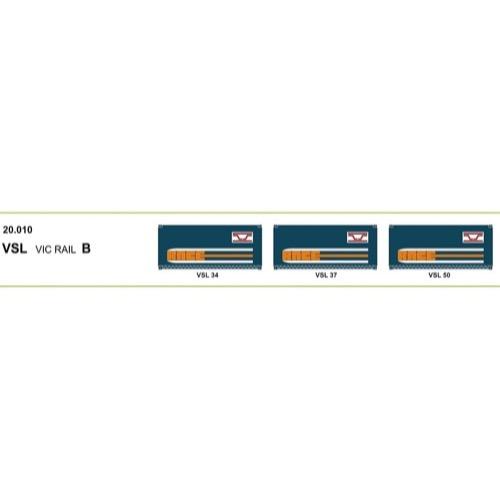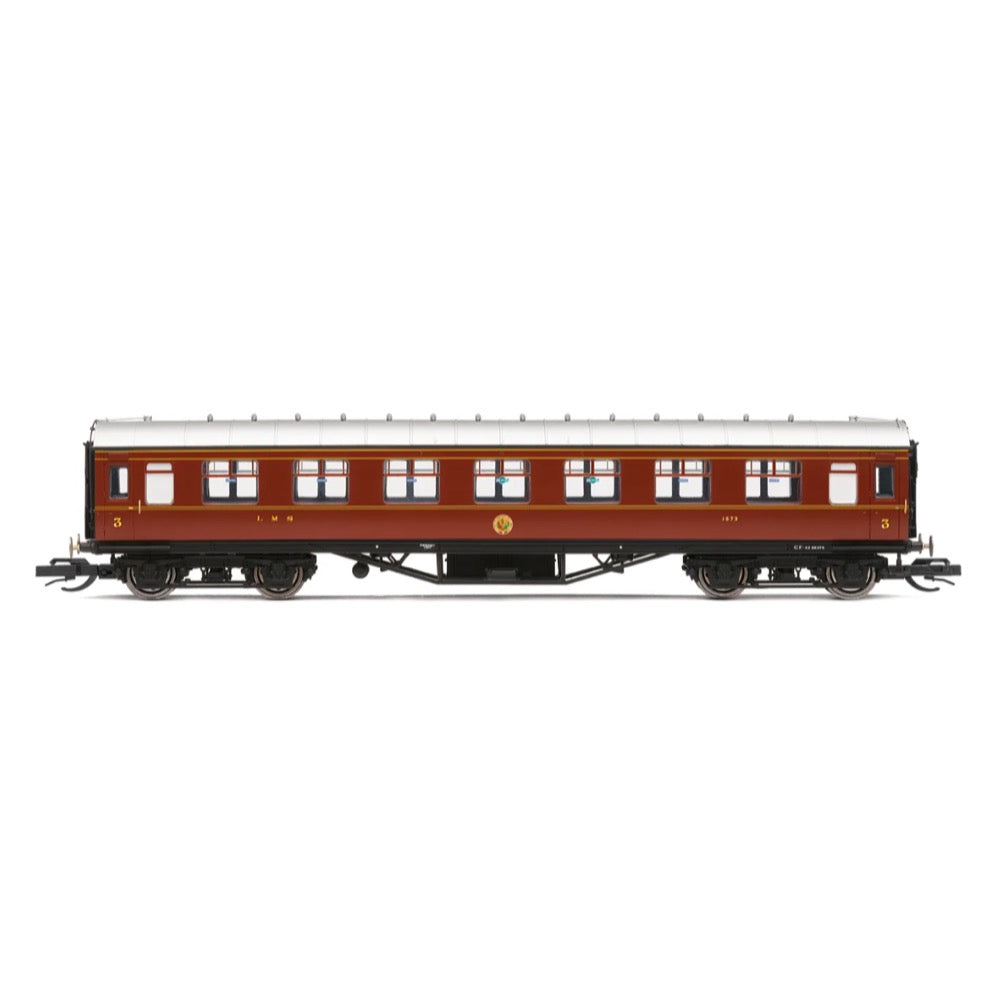
Hornby TT4008A TT LMS 57 Corridor Third 1573
At the start of the 1930s the LMS abandoned the ‘Small Engine Policy that it had inherited from one of its largest predecessors, the Midland Railway. The abandoning of this policy led to some of the most famous Stanier and LMS designs such as the Jubilee, Black 5 and Duchess classes. To accompany this shift in ethos, new coaches were constructed for the LMS, with the 57’ coaches being built between 1931 and 1932.
These new coaches were steel clad, the first such for the LMS and had seating for 56, 300 such examples were built. In LMS service these coaches were painted in their striking maroon livery with LMS insignia adorning the side. The coaches, being relatively new at the time of nationalisation lasted well into the swansong days of BR, appearing in both its carmine and cream livery and later BR Maroon when BR decided to shift aesthetics back to regional recognition.
Specifications
- Item Length - Without Packaging (cm): 14.4
- Item Height - Without Packaging (cm): 3
- Item Width - Without Packaging (cm): 2.2
- Item Weight - Without Packaging: 0.04
- Item Scale: 1:120 Scale
- Finish: Painted
- Colour: Maroon
- Gauge: TT
- Operator: LMS
- Designer: Sir William Stanier
- Livery: LMS Maroon
- Minimum Curve (mm): Radius 3
- Number of Parts: 1

Hornby TT4012 TT BR Intercity Mk2E First Open 3234
The British Rail Mark 1 coaches were not suitable for higher speed rail services, with the Mark 1 coaches being a perfect compliment for steam locomotives which saw themselves being replaced by diesel and electric locomotives as the 1960s progressed. The Mark 2 coach was introduced in 1964 and was all steel. While the Mark 2 was a progression of the Mark 1, the two shared almost no common parts, and only a passing resemblance.
In service, the Mark 2 coaches were commonly seen in the BR Blue and Grey livery and Network South East colours. The coaches were mainly hauled by larger express diesel and electric locomotives such as the Class 40, 47 and 86. As of 2022, the only Mark 2 coaches still in service are those that are part of the Network rail fleet.
The Mark 2 E coaches were fitted with luggage racks opposite the toilets at the end of each coach. The toilets themselves were reduced in size from the preceding variants. The gangway doors on Mark 2 E coaches were cream folding doors of a plastic construction.
Specifications
- Item Length - Without Packaging (cm): 16.8
- Item Height - Without Packaging (cm): 3
- Item Width - Without Packaging (cm): 2.2
- Item Weight - Without Packaging: 0.04
- Item Scale: 1:120 Scale
- Finish: Painted
- Colour: Multiple
- Gauge: TT
- Operator: BR
- Designer: BR
- Livery: Intercity Executive
- Minimum Curve (mm): Radius 1
- Number of Parts: 1
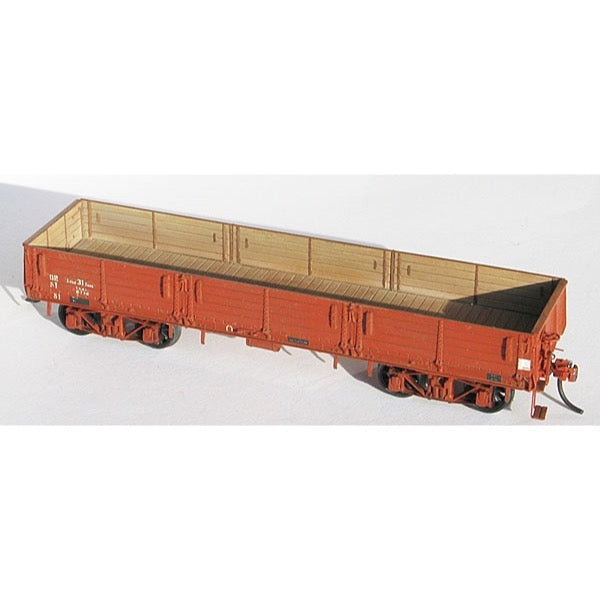
Steam Era Models R27B HO QR Bogie Open Wagon with Bar Frame Bogies Kit
QR Bogie Open Wagon Kit
QR number 1 was built at the VR Newport workshops in 1889, being the forerunner of a long lived and useful class of wagon. Wright and Edwards of Braybrook built 150 wagons, numbered 2 to 151 in 1890/91 with a further 50 wagons, numbered 152 to 201 constructed by the VR at Braybrook in 1892. These wagons were built with swing motion diamond frame bogies, a composite steel and wood underframe with truss rods and were rated at 26tons capacity. Construction of QR resumed in 1912 with a further 175 wagons constructed to a slightly altered design. featuring plate frame bogies, in the following two years. During the 1930s the fleet were rebuilt with all steel underframes, auto-couplers and heavier bracing for the ends. The brake equipment on wagons 1-201 was altered from a combination brake cylinder-auxiliary reservoir to a larger brake cylinder with separate auxiliary reservoir. The all steel underframe was stronger and the rated capacity increased to 30 tons, with a further increase to 31 tons in the late 1950s when buffers and truss-rods were removed.The kit represents a wagon as running from the mid to late 1950s until final withdrawal in the 1990s.
Includes etched details and Bar Frame Bogies.

Tomix 98532 N E7 Hokuritku Joetsu SHINKANSEN Addon set B 4 cars
The E7 Series Shinkansen is a Shinkansen train that was introduced in 2014. It was developed in preparation for the opening of the Hokuriku Shinkansen at Kanazawa Station in 2015, and began commercial operation on the Joetsu Shinkansen in 2019.
In recent years, baggage storage areas have been added inside the train to accommodate larger baggage, so some of the windows are now blocked off.
Features
- Reproduces the appearance with some of the windows blocked off to accommodate the added luggage storage area
- Reproduces the anti-slip surface on the roof with gray printing
- Car numbers are selectable and a transfer sheet is included
- A full 12-car formation can be reproduced by combining this product (cars 4, 5, 6, and 7) with product numbers 98530 and 98531
- Equipped with movable hood
- Equipped with movable pantograph
- Uses hook and U-shaped conductive couplers
- Car number markings (on the car body and roof) are printed
- Uses power with flywheel
- Uses a new current collection system and silver wheels
- Uses an M-13 motor
Vehicles
- E726-200
- E725-100
- E726-300
- E725-400(M)
Accessories
- Parts: Powered bogie mounting auxiliary rod
- Transfer sheet: Car number, etc.
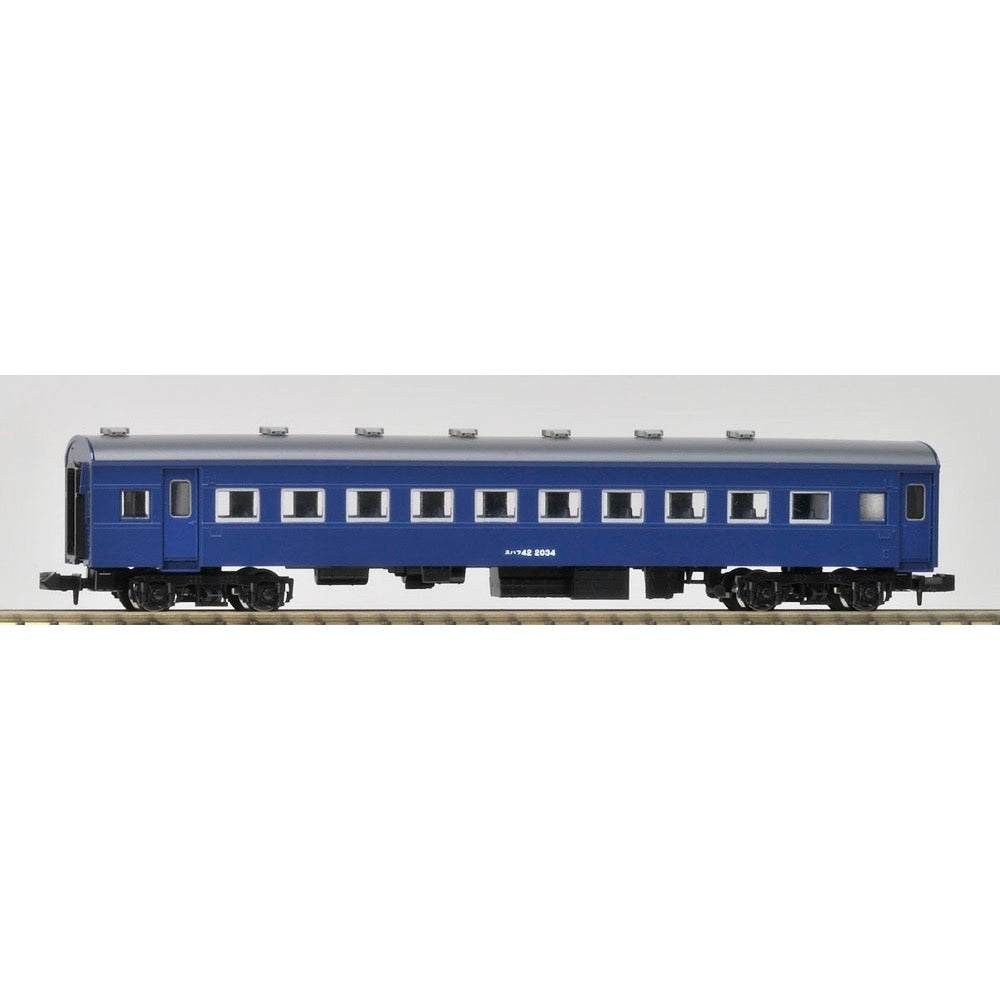
Tomix 9511 N SUHAFU42 Aluminum Sash Blue
The SuHaFu 42 type was a third-class brake car manufactured for express trains and was introduced in 1951.
There is a conductor's room at the end of the car, and a rear observation window on the end. Some cars had their passenger windows replaced with aluminum sash frames in later years, and the silver window frames were an accent to the exterior.
Features
- Reproduces the SuHaFu 42 type, a brake van of the SuHa 43 series
- The body color is the blue of the modernization modification, and reproduces the vehicle with aluminum sash window frames
- The boarding and alighting doors are reproduced with steel H-rubber windows, which can be replaced with large steel H-rubber windows with optional parts sold separately
- The underfloor equipment and end beam parts are reproduced with electric heating cars
- Includes dummy couplers, end beam parts, and release lever parts to enhance the sense of detail at the end of the car
- The car number is selectable and a transfer sheet is included
- The taillights on the end of the conductor's compartment side can be lit, with an ON/OFF switch
- Uses a new current collecting system and black wheels
- Compatible with optional self-coupled TN couplers
Contents
Vehicle
- SuHaFu42 (aluminum sash, blue)
Accessories
- Parts: Dummy coupler body
- Parts: Dummy coupler base
- Parts: End beam
- Parts: Bogie frame (without coupler branch)
- Transfer sheet: vehicle number, etc.
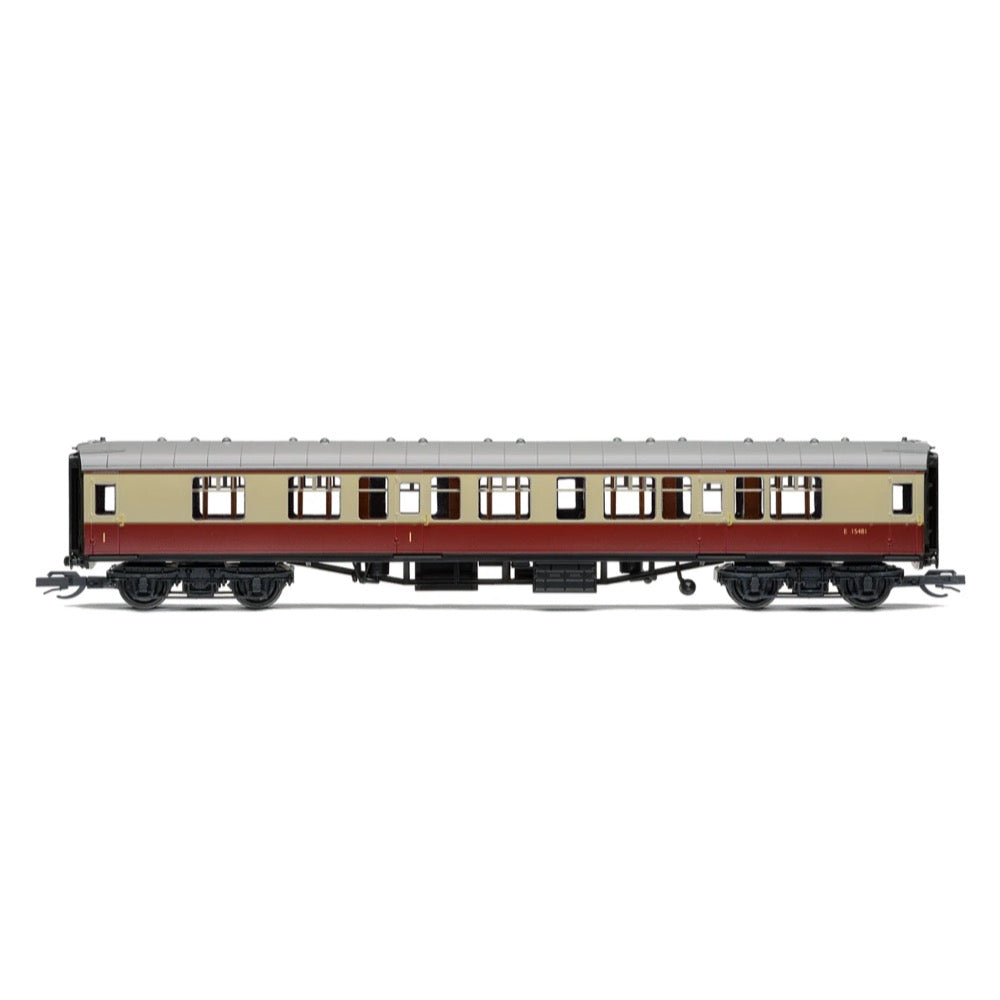
Hornby TT4005B TT BR Mk1 Composite Corridor E15481
Upon nationalisation in 1947 the newly formed British Railways saw the need to standardise their passenger stock, having inherited a patchwork of coaches of all different specifications from each of the big four who were in turn sometimes running a wide variety of stock from their constituent companies. This new coach would have to be perfect for every possible use that the new BR may need it for, which could be tricky when the coach would need to be used on high speed summer boat trains in the south and cold winter services in the north of Scotland.
These coaches would be constructed from 1951 to 1963 with only one significant change made during this time, a swapping of bogies in the last gasps of the Mark 1s build cycle. The Mark 1 coach as it would be designated was designed to be a ‘go anywhere, do anything’ coach utilising the best features from each of the big four coaches the company had inherited. The Mark One coaches were stronger than the designs they replaced, with their introduction being commended in rail safety reports. These coaches would be in stock in one form or another in the UK until 2010, when the Mark One based Class 421 was withdrawn from service on the Lymington Branch Line.
Specifications
- Item Length - Without Packaging (cm): 16.6
- Item Height - Without Packaging (cm): 2
- Item Width - Without Packaging (cm): 2.1
- Item Weight - Without Packaging: 0.04
- Item Scale: 1:120 Scale
- Finish: Painted
- Colour: Red
- Gauge: TT
- Operator: BR
- Designer: British Railways
- Livery: Carmine and Cream
- Minimum Curve (mm): Radius 1
- Number of Parts: 1
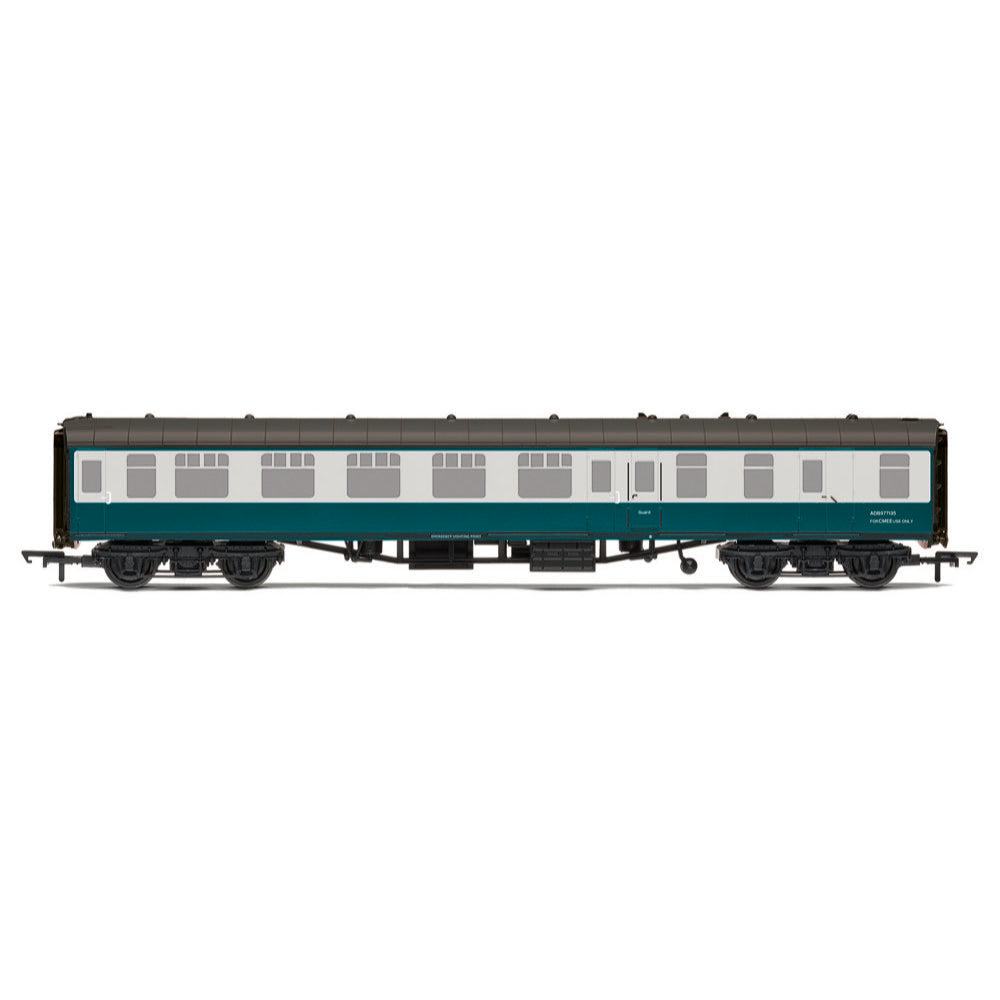
Hornby R40348 OO BR Mk1 BSO ADB977135
British Railways Mark 1 is the family designation for the first standardised designs of railway carriages built by British Railways (BR) from 1951 until 1974, now used only for charter services on the main lines or on preserved railways.
Following nationalisation in 1948, BR had continued to build carriages to the designs of the "Big Four" companies (the Great Western, Southern, London Midland and Scottish and London and North Eastern railways), and the Mk1 was intended to be the standard carriage design for use across all lines, incorporating the best features of each of the former companies' designs. It was also designed to be much stronger than previous designs, to provide better protection for passengers in the event of a collision or derailment.
An unusual feature of the design was the bodyside tumblehome curvature, of 28 ft (8.53 m) radius and just noticeable; the windows had flat glass and consequently the upper quarter was separate and in a different plane from the lower glazing, with an intervening transom, and the steel panels were recessed on either side of each window opening to accommodate the difference between the flat glass and the curved sides. The opening portion of the windows were provided with sliding ventilators, with an external aerofoil for draught-free ventilation, the correct opening position being marked by a pair of arrows.
Doors were provided with frameless droplights manufactured by Beclawat; these were supported by a spring-loaded lazytongs mechanism inside the lower part of the door, and the top of the window had a sprung metal clip engaging in slots on either side of the window opening. Mk1s were painted in a stunning array of liveries, and our model carries with it a smooth and soft blue and grey.
Specifications
- Item Length - Without Packaging (cm): 26.5
- Item Height - Without Packaging (cm): 5
- Item Width - Without Packaging (cm): 3.5
- Item Weight - Without Packaging: 0.14
- Item Scale: 1:76 Scale 00 Gauge
- Finish: Painted
- Colour: Grey and Blue
- Operator: BR Departmental
- Designer: BR
- Livery: BR
- Minimum Curve (mm): Radius 2
- Number of Parts: 1
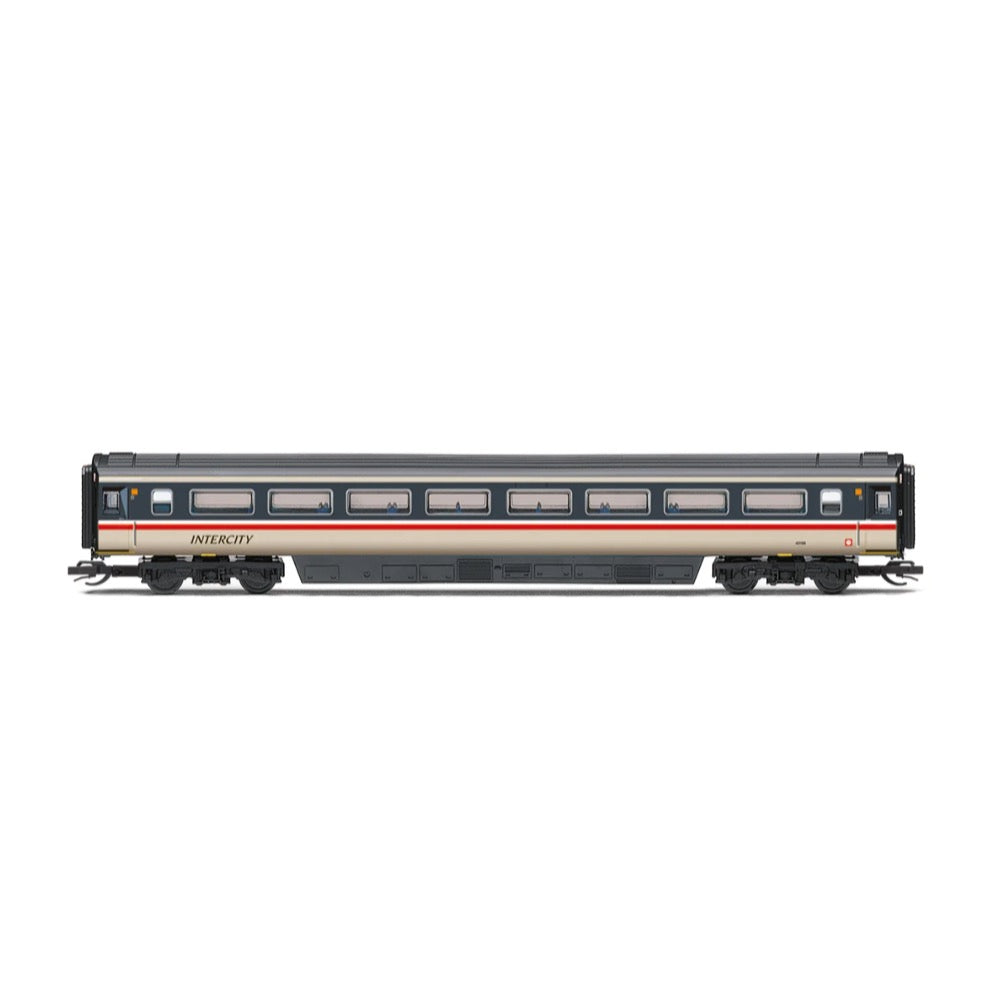
Hornby TT4027A TT BR Intercity Mk3 Tourist Standard Open 42198
In-order to allow running at 125 mph on Britain's Victorian era railways, new rolling stock was needed by British Railways. Significant improvements over the Mk2 included new secondary air suspension between the bogies and the coach body as well as aerodynamic skirting on the underframe.
Mk3 coaches are 75ft (23m) long, enabling far greater capacity than older coaches. Mk3 coaches also incorporate disk brakes and wheel slip protection enabling faster deceleration. The first Mk3 coaches to be delivered were used as part of the HST prototype along with the two Class 41 diesel power cars in 1972. Mk3 coaches entered service in 1975 along with the Class 43 forming the iconic InterCity 125 trainset. After the HST Mk3 coach variant was introduced, further Mk3 coaches were introduced to the West Coast Mainline for use as part of locomotive hauled trains. Whilst Mk3 stock is standard for HST units, the standard locomotive hauled stock is Mk3a. Mk3a stock differs from Mk3 stock due to the inclusion of buffers as well as a different electrical system that uses motor generator units in each coach to power air conditioning and other ancillaries Mk3a stock was built until 1984, before 3B stock with improved seating and lighting was built from 1985 to 1988.
As BR began to move away from the corporate blue livery, some of the Mark 3 coaches and complimentary Class 43 units were painted into a new Intercity Executive livery. This livery consisted of a dark grey upper body, a stripe of white and red and a light beige sand colour on the bottom of the body. While this would be a popular and long lasting livery, the name Executive was dropped from the side of the units as the livery took over as the only one applied to Intercity sets.
Specifications
- Item Length - Without Packaging (cm): 19
- Item Height - Without Packaging (cm): 2.2
- Item Width - Without Packaging (cm): 2
- Item Weight - Without Packaging: 0.05
- Item Scale: 1:120 Scale
- Finish: Painted
- Colour: Multiple
- Gauge: TT
- Operator: BR
- Designer: BR
- Livery: BR Intercity
- Minimum Curve (mm): Radius 1
- Number of Parts: 1
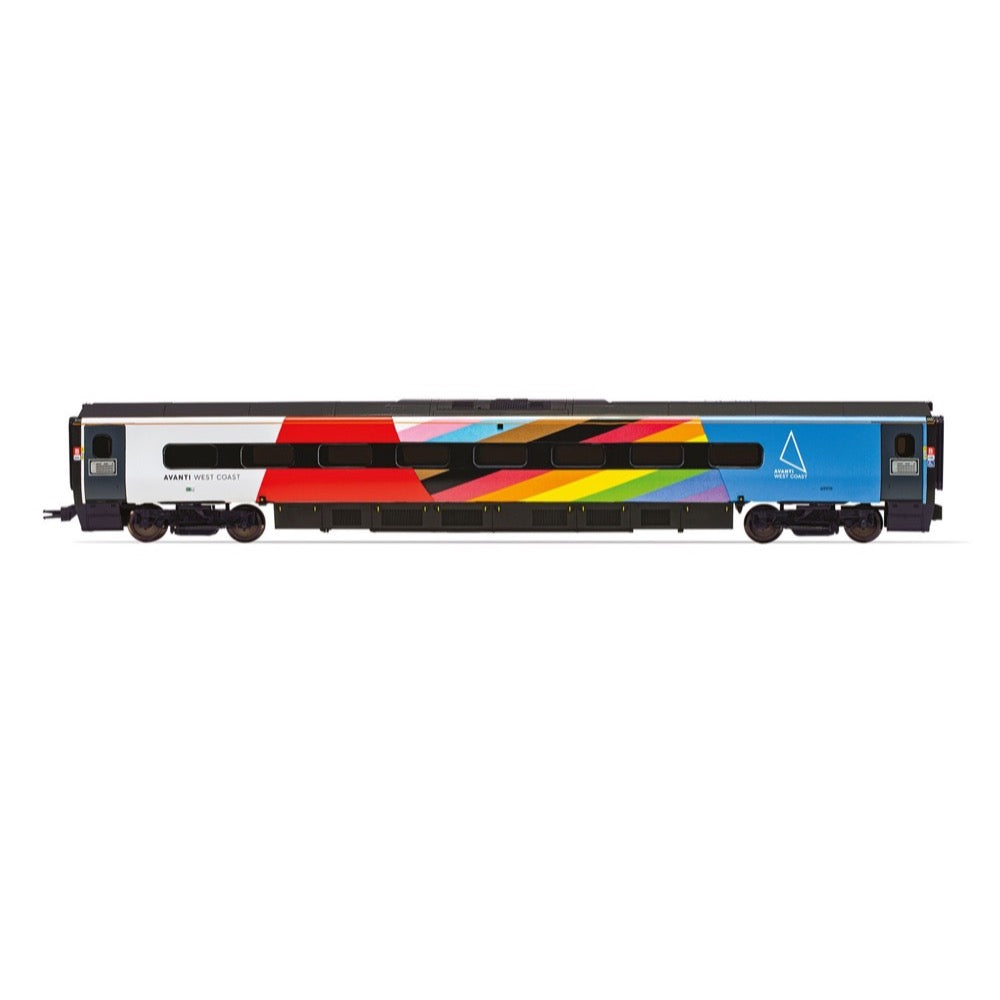
Hornby R40200 OO Avanti West CoastPendolino Motor Standard (MS) Pride Livery
On the 25th of August 2020 Avanti West Coast unveiled a new livery for one of its train-sets. Billed as the biggest Pride flag the UK has seen on the side of a train, the new livery wraps the full length of the 11 carriages in the Progressive Pride flag colours. The first service of this newly liveried train was staffed by a LGBTQ+ crew with the train filled with literature, stories and colourful posters featuring Pride related information as well as fun facts during the onboard announcements.
This coach can be used to expand set R30081 to a 9-car set.
Specification
- Item Length - Without Packaging (cm): 33.5
- Item Height - Without Packaging (cm): 5
- Item Width - Without Packaging (cm): 3.5
- Item Weight - Without Packaging: 0.2
- Item Scale: 1:76 Scale 00 Gauge
- License: No
- Finish: Painted
- Colour: Mixed
- Gauge: OO
- Operator: Avanti West Coast
- Designer: Alstom
- Livery: Avanti Pride
- Minimum Curve (mm): Radius 2
- Number of Parts: 1


